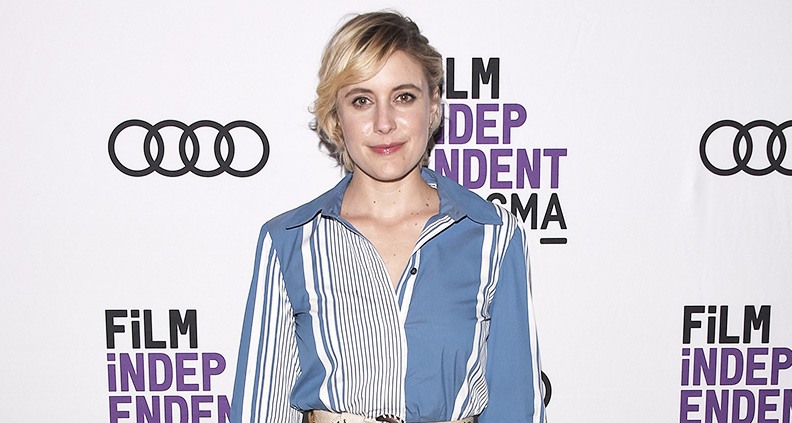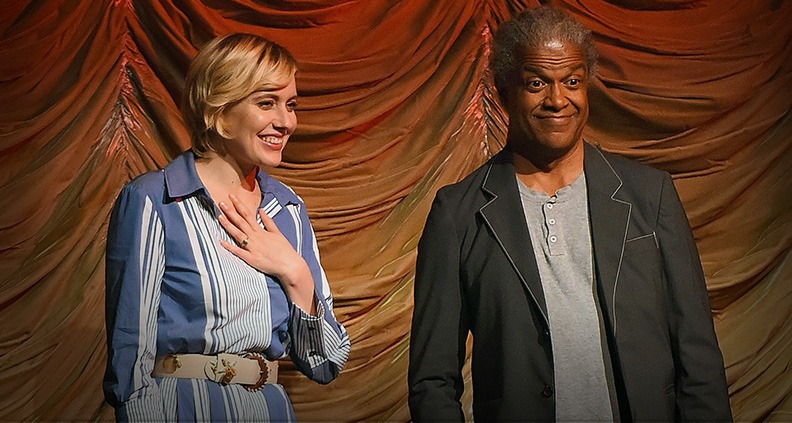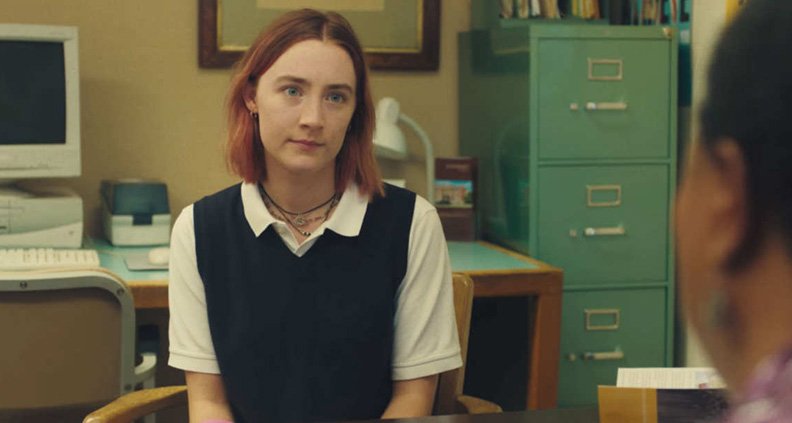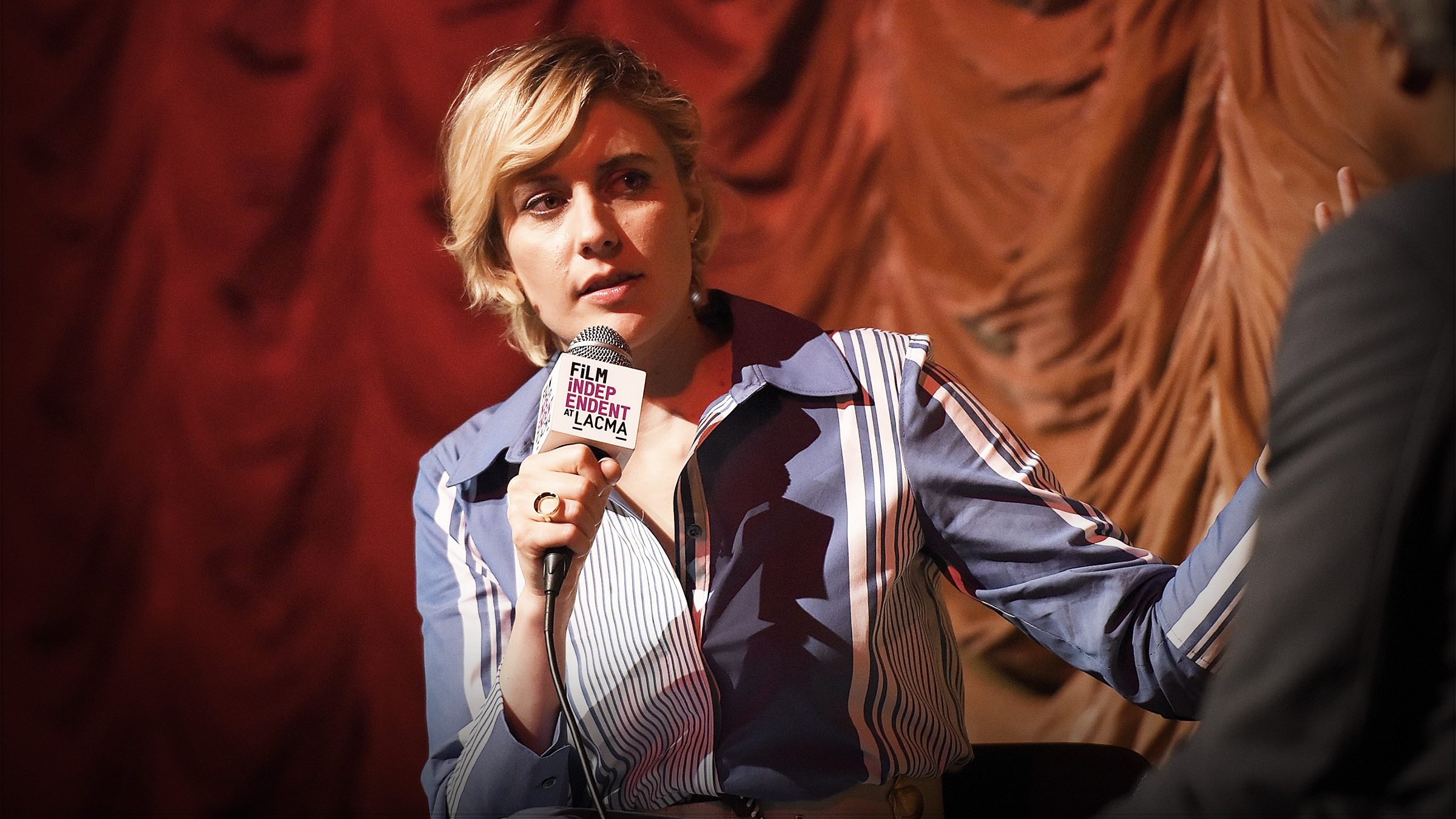Greta Gerwig Brings it All Back Home with ‘Lady Bird’
On November 2, Film Independent at LACMA screened Greta Gerwig’s acclaimed directorial debut Lady Bird in front of a packed house—followed by an engaging post-screening discussion with Gerwig moderated by Film Independent at LACMA Curator Elvis Mitchell. The film, a semi-autobiographical coming-of-age tale following one year in the life of a young woman (Saoirse Ronan) living in suburbs of Sacramento, is in theaters now.
Heretofore best known as the charismatic lead of such indie hits as Hannah Takes the Stairs (2007), Frances Ha (2013) and Mistress America (2015)—the latter two of which she also co-wrote—Gerwig spoke to her early experience on film sets as performer, which essentially became her film school. On editing: “I would watch how the footage was put together, which makes you instantly not vain as an actor. You just become very vigorous about what you’re doing and what’s working, what’s not working.”

Mitchell asked what the first day on set was like, this time in the director’s chair. Gerwig said if anything she over-prepared, filmmaking being a “timed” art form. “I spent so much [time] in prep with my cinematographer, my first AD, my design team,” she said, spending as much time working out the details with her collaborators “before someone was sitting there with a stopwatch and money was running.” To that end, Gerwig and cinematographer Sam Levy developed a clear game plan for Lady Bird, creating a shot list, storyboarding and rehearsing on location with the actors.
For Gerwig, it was truly gratifying to see people actualize her vision. “It’s this simultaneous moment of supreme control, because it’s your words and it’s your vision,” she said, “and also complete lack of control because they [the actors and crew] are the keepers of the words and the ideas.” Gerwig described the feeling as “intoxicating.”

Mitchell spoke about the line between adult behavior and teen behavior in the film. Gerwig said she wanted the adult world to be just as vivid as the teenage world, trying to find the balance between them. “I wanted this film to be equally the mother’s story as much as Lady Bird’s story, and also the story of a community as much as it’s the story of this girl.”
Gerwig mentioned that in the original draft of the film, the title was Mothers and Daughters. From the project’s inception, she wanted to present two distinct sides. She said that what is shared in Frances Ha, Mistress America and now Lady Bird “is a deliberateness around wanting to make a story where their primary emotional relationship is not heterosexual romance.” Frances Ha is centered on two friends. Mistress America deals with two stepsisters. And Lady Bird highlights the relationship of a middle-aged mother and her teenage daughter.
Although the film feels autobiographical, Gerwig says that she was actually the opposite of Lady Bird. She is from Sacramento and did attend an all-girls Catholic school, but never actually died her hair pink or made people call her by an alternative name. “I was a rule-follower and a people-pleaser and I really wanted the gold star,” she said. “I think in a way writing this character who is so out there, it was a way of accessing something that I couldn’t consciously.”

Gerwig quoted Virginia Wolfe who wrote, “Men don’t know what women do when they’re not there.” And in Lady Bird, Gerwig was looking to capture intimate moments between women.
“These moments that have remained hidden because authorship has only been extended to a certain kind of person,” she said. “That’s why I’m so interested in seeing films by people who are not usually in the canon of who’s allowed, because they can show you something you’ve never seen before.”
Often films only validate female characters through romantic relationships. Gerwig was determined to build characters that were striving towards personhood. “I think Lady Bird experiences the exact same thing everybody does—when you’re sure life is happening somewhere else and it’s not happening to you. You get to the place that life is happening and you look around and go ‘it’s been happening all along.’”

Mitchell spoke to the many scenes in the film that display life in cars. Gerwig said that she watched John Huston’s Fat City for tips on incorporating local color, which was shot in Stockton, CA close to Sacramento.
“I also looked at American Graffiti because that was shot in Modesto,” she said. “I was looking at the car life they experience, cruising around, looking for friends,” She noted that this very much encapsulated her teenage years—life without cell phones.
Mitchell and Gerwig capped off the Q&A by discussing a comical scene: Lady Bird and her mother listening to The Grapes of Wrath on tape. After sharing an emotional moment in the car, Lady Bird instantly reverts to being impolite. “And they just heard the story of people who died to get there [California] and she’s saying she wants to go live in New Hampshire,” Gerwig said, amused.
“She’s always looking for the next thing, the next song, the next stimulus.” Lady Bird is eager to get out of her hometown, until she ends up in New York and realizes that life was always happening. “And there’s no other place that life is happening,” Gerwig said.
Lady Bird is currently playing select theaters—check out the film’s website for more information.
To see what’s coming up at Film Independent at LACMA, click here. And learn how to become a Member of Film Independent by clicking here. Not a Member of Film Independent yet? Become one today.